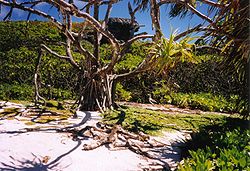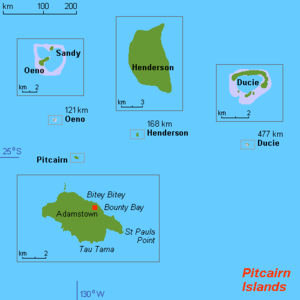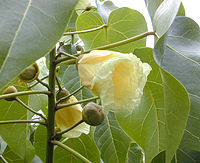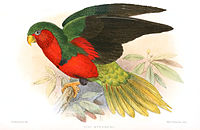Henderson Island
| Henderson island | |
 Shelter on Henderson Island | |
|---|---|
| Location | |
| Location: | 24°21’0"S, 128°19’0"W |
| Data | |
| Population: | 0 |
Henderson Island is an uninhabited raised coral atoll in the south Pacific Ocean. It is part of the territory of the Pitcairn Islands, though far separated from Pitcairn. It has formerly also been known as San Juan Bautista and Elizabeth Island.
This is one of the few atolls whose ecosystems have been relatively unaffected by human contact. Ten of its 51 flowering plants, all four of its land birds and about a third of the identified insects and gastropods are endemic, a remarkable diversity given the island's size.[1]
Measuring 6 miles long and 3.2 miles wide, it has an area of 14.4 square miles and is to be found in the ocean 120 miles northeast of Pitcairn Island. Henderson is unsuitable for agriculture and has little fresh water. There are three beaches on the northern end and the remaining coast comprises steep, mostly undercut, cliffs up to 50 feet in height.
In 1902 Henderson was annexed to the Pitcairn Islands colony, now a British overseas territory. It was designated a World Heritage Site by the United Nations in 1988.
Contents
History
Archaeological evidence suggests that a small permanent Polynesian settlement existed on Henderson at some time between the twelfth and fifteenth centuries.[2] The reasons for the group's disappearance remain unknown, but may relate to the similar disappearance of the Polynesians on Pitcairn Island, on whom the Hendersonians would have depended for many of the basics of life, especially stone for making tools.[3] The Pitcairn Polynesians may in turn have disappeared because of the decline of nearby Mangareva (now part of French Polynesia); thus, Henderson was at the end of a chain of small, dependent colonies of Mangareva.[4]
On 29 January 1606 a Spanish expedition led by the Portuguese sailor Pedro Fernandes de Queirós discovered Henderson Island and named it San Juan Bautista.[5] On 17 January 1819 the British Captain Henderson of the British East India Company ship Hercules re-discovered the island and named it Henderson Island. On 2 March 1819 Captain Henry King, sailing aboard the Elizabeth, landed on the island to find the king's colours already flying. His crew scratched the name of their ship into a tree, and for some years the island's name was Elizabeth or Henderson, interchangeably.
On November 20, 1820, the Nantucket whaler Essex was rammed by a sperm whale and sunk (a report of which inspired Herman Melville to write Moby Dick), and the survivors arrived at Henderson on 20 December in three small whaleboats. They found the island's only known drinkable water-source – a brackish spring on the north shore, exposed only at half tide, rising from a crevice in a flat rock, large surfaces of which compose the face of the beach – and ate fish, birds, eggs, crabs and peppergrass; but they had largely exhausted the ready food within a week and on 27 December the three boats set sail for South America, leaving behind Thomas Chappel, Seth Weeks and William Wright who had chosen to stay, and who survived until their rescue on 9 April 1821. In his account of the ordeal, Chappel reported having seen human skeletons in a cave.[6]
In August 1851 visitors from Pitcairn Island also found skeletons in a cave and wreckage on the adjacent beach. After a party of Pitcairners collecting miro wood re-discovered the skeletons in March 1958, a medical examination determined that the bones were of White European origin, and they were then buried in a shallow grave inside the cave. Finally, an American survey team examined the bones in 1966 and buried them in five coffins in the left-hand corner of the cave, tightly jamming a large cross between the ceiling and the rock floor at the entrance. They concluded the remains were of five or six people, one of whom was between three and five years of age. It is presumed they were the survivors of a shipwreck who died of dehydration.[7]
Henderson, along with Oeno and Ducie, was formally annexed to the British Empire in 1902 by Captain G F Jones who visited the islands in a cutter with a crew of Pitcairn Islanders; and in August, 1937, HMS Leander on a journey from Europe to New Zealand carried out an aerial survey of Henderson, Oeno and Ducie, and on each island a British flag was planted and an inscription was nailed up proclaiming "This island belongs to H.B.M. King George VI." [8]
In 1957 a twenty-seven-year-old American, Robert Tomarchin, lived the life of a castaway on the island for approximately two months, accompanied by a pet chimpanzee, apparently as a publicity stunt, until people from Pitcairn rescued him in two longboats.[9]
In the early 1980s American businessman Arthur "Smiley" Ratliff expressed interest in establishing a home for himself with an airstrip on the island.[10] The Pitcairn Island Council approved his plans in April 1981 but the British Foreign and Commonwealth Office overrode the decision and vetoed the proposed development, after environmentalist groups had lobbied to protect the natural ecology and environment of the island. Henderson Island was subsequently listed as a World Heritage site in 1988.[1]
Natural resources
Since the introduction of aluminium-hulled long-boats in the 20th century, Pitcairners have made regular trips to Henderson to harvest the wood of miro trees (Thespesia populnea) and tou trees (Cordia subcordata). Usually they venture to Henderson once a year, but they may make up to three trips if the weather is favourable. Pitcairners carve the wood into curios for tourists, from which they derive much of their income.[11]
Geography
Henderson Island is a raised coral atoll that, with Pitcairn, Ducie and Oeno Islands, forms the Pitcairn Island Group. The nearest major landmass is more than 3,000 miles away. This coral limestone island sits atop a conical (presumed volcanic) mound, rising from a depth of roughly 11,500 feet. Its surface is mostly reef-rubble and dissected limestone; an extremely rugged mixture of steep, jagged pinnacles and shallow sink holes, and the island is encircled by steep, undercut limestone cliffs on all but the north end. There are three main beaches, on the north-west, north, and north-east sides, and the north and north-west sides are fringed by reefs. The depression at the island's centre is thought to be a raised lagoon. There is only one known potable (drinkable) water source, a brackish spring, exposed briefly at low tide. The surrounding ocean tidal range is about three feet at spring tide.[1]
Flora
Apart from five species found bordering the beaches, including coconut palms, the vegetation is undisturbed. Henderson Island is covered by tangled scrub forest 15 to 30 feet tall, more thinly covered in the central depression. It has 51 native species of flowering plants, ten of which are unique to the island (endemic). Dominant tree species include coconut, Pandanus tectorius, Thespesia populnea, Tournefortia argentea, Cordia subcordata, Guettarda speciosa, Pisonia grandis, Geniostoma hendersonense, Nesoluma st.-johnianum, Hernandia stokesii, Myrsine hosakae, and Celtis|Celtis sp.[12]
Fauna
Birds
The island is presently home to four endemic land bird species – the Henderson fruit dove, Henderson lorikeet, Henderson reed warbler and the flightless Henderson crake. The Henderson Lorikeet (Vini stepheni) is also known as the Stephen's Lorikeet and is a species of parrot in the Psittacidae family.
Three species of the dove (Columbidae) family – the Henderson round dove, the Henderson imperial pigeon and the Henderson archaic pigeon – were formerly endemic to the island, but became extinct when the Polynesians arrived around AD 1000. Of the fifteen non-endemic seabird species found, nine or more are believed to breed on the island.[1] Breeding colonies of the globally endangered Henderson petrel formerly existed on Ducie, but were wiped out by invasive rats by 1922. It is believed to now nest uniquely on Henderson island.[13]
Bones associated with prehistoric Polynesian settlement sites dating to somewhere between 500 and 800 years ago include those of the Polynesian storm petrel, Marquesan imperial pigeon, and Polynesian or Pacific imperial pigeon which are no longer found on the island, and two others – Christmas shearwater and red-footed booby – that still visit but no longer nest. It is hypothesized that the Polynesian settlers may have driven these bird species, along with six terrestrial snail species, to local extinction, and this loss of a ready and regular food supply may have contributed to the Polynesians' subsequent disappearance.[14][15]
The island has been identified by BirdLife International as an 'Important Bird Area' for its endemic landbirds and breeding seabirds.[16]
Other animals
The invertebrate species are largely unknown but a third of the known snails and insects are endemic.[1] There are no native mammals but the Pacific rat, introduced by Polynesians 800 years ago, abounds.[17] A skink (Emoia cyanura), and the green sea turtle have been identified, and an unidentified gecko has been reported.
Biological risk
Land bird populations appear to be relatively stable but there is high risk of introduction to the island of predators, disease vectors and diseases by unauthorised landings of yachts. Introduction of the Eurasian black rat or the domestic cat would be likely to cause almost immediate extinction of the ground dwelling Henderson Crake and possibly other species. The endemic birds may have no immunity to the fatal avian pox which is transmitted by biting flies such as hippoboscidae.[12]
Between July and November 2011 a partnership of the Pitcairn Islands Government and the Royal Society for the Protection of Birds implemented a poison baiting programme aimed at eradicating the Pacific rat. A subsequent expedition has demonstrated the persistence of a rat population, if greatly reduced, and growth in the size of some of the island's unique bird populations.[18]
Outside links
| ("Wikimedia Commons" has material about Henderson Island) |
References
- ↑ 1.0 1.1 1.2 1.3 1.4 UNESCO World Heritage listing
- ↑ Henderson Island crania and their implication for Southeastern Polynesian prehistory - Vincent H Stefan (Journal of the Polynesian Society, 2002)
- ↑ Diamond, Jared (2005). Collapse: How Societies Choose to Fail or Succeed. Penguin Group. ISBN 0-670-03337-5.
- ↑ Weisler, Marshall I. (1995). "Henderson Island prehistory: colonization and extinction on a remote Polynesian island". Biological Journal of the Linnean Society 56 (1–2): 377–404. doi:10.1111/j.1095-8312.1995.tb01099.x.
- ↑ Brand, Donald D. The Pacific Basin: A History of its Geographical Explorations The American Geographical Society (New York, 1967) p.136.
- ↑ Thomas Farel Heffernan (1 September 1990). Stove by a Whale: Owen Chase and the Essex. Wesleyan University Press. pp. 62–84. ISBN 978-0-8195-6244-9. http://books.google.com/books?id=qgaD97DaxfQC&pg=PA84. Retrieved 25 July 2013.
- ↑ Pitcairn Islands Study Center. History of Government and Laws, Part 15
- ↑ Rehder HA & Randall JE (January 15, 1975). "Ducie Atoll: Its history, physiography and biota". Atoll research bulletin 183: 1–55. doi:10.5479/si.00775630.183.1. http://www.sil.si.edu/DigitalCollections/atollresearchbulletin/issues/00183.pdf.
- ↑ Winthrop, Mark. "The Henderson Island monkey story". http://library.puc.edu/pitcairn/pitcairn/monkey.shtml. Retrieved 21 May 2011.
- ↑ Serpell J. "Desert island risk". New Scientist (5 May 1983): 320. http://books.google.com.au/books?id=fdvrCZFHhGgC&pg=PA320=true.
- ↑ Brooke, M. de L.; I. Hepburn; R.J. Trevelyan (2004) (PDF). Henderson Island World Heritage Site Management Plan 2004–2009. Foreign and Commonwealth Office, London. p. 19. http://www.ukotcf.org/pdf/henderson.pdf. Retrieved 31 March 2009.
- ↑ 12.0 12.1 Graves GR (1992). "The endemic land birds of Henderson Island, Southeastern Polynesia: Notes on natural history and conservation". The Wilson Journal of Ornithology 104 (1): 32–43.
- ↑ http://www.int-res.com/articles/esr2010/11/n011p047.pdf
- ↑ Steadman DW, Olson SL (September 1, 1985). "Bird remains from an archaeological site on Henderson Island, South Pacific: Man-caused extinctions on an “uninhabited” island". PNAS 82 (18): 6191–6195. http://www.pnas.org/content/82/18/6191.full.pdf+html.
- ↑ http://faculty.washington.edu/plape/pacificarchwin06/readings/Weisler--settlement%20of%20marginal%20polynesia.pdf
- ↑ BirdLife International. (2012). Important Bird Areas factsheet: Henderson Island. Downloaded from http://www.birdlife.org on 2012-01-21.
- ↑ http://www.birdlife.org/community/2011/12/aircraft-carrier-and-helicopters-come-to-unique-islands-rescue/
- ↑ Royal Society for the Protection of Birds. "Henderson Island Restoration Project". http://www.rspb.org.uk/ourwork/projects/details.aspx?id=tcm:9-241934. Retrieved 28 May 2012.
Further reading
- Jared Diamond, Collapse: How Societies Choose to Fail or Succeed (2005), ch. 3.
- Nathaniel Philbrick, In the Heart of the Sea: The Tragedy of the Whaleship Essex, Penguin Books 2001.
- Chase, Owen (1821). Narrative of the Most Extraordinary and Distressing Shipwreck of the Whale-Ship Essex. W. B. Gilley. No ISBN. New York.
- Nickerson, Thomas (1984). The Loss of the Ship "Essex" Sunk by a Whale and the Ordeal of the Crew in Open Boats. Nantucket Historical Society.
| The Pitcairn Islands |
|---|
| World Heritage Sites in the British Overseas Territories |
|---|
|
Gough Island and Inaccessible Island, Tristan da Cunha • Henderson Island (Pitcairn Islands) • Town of St George and Related Fortifications |


